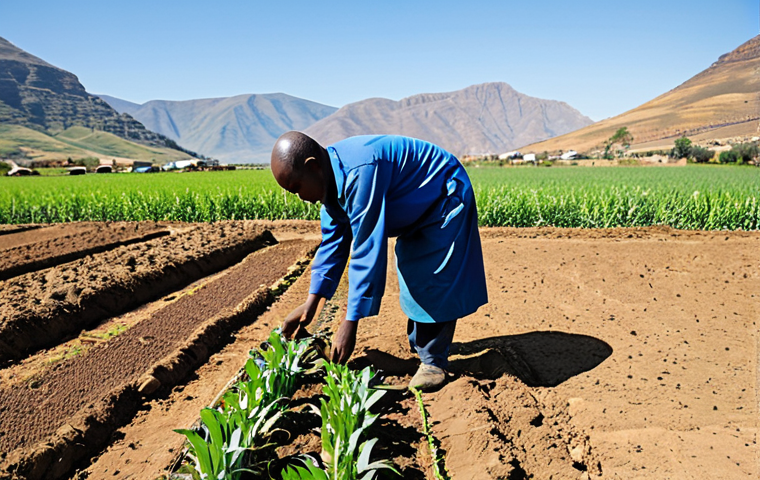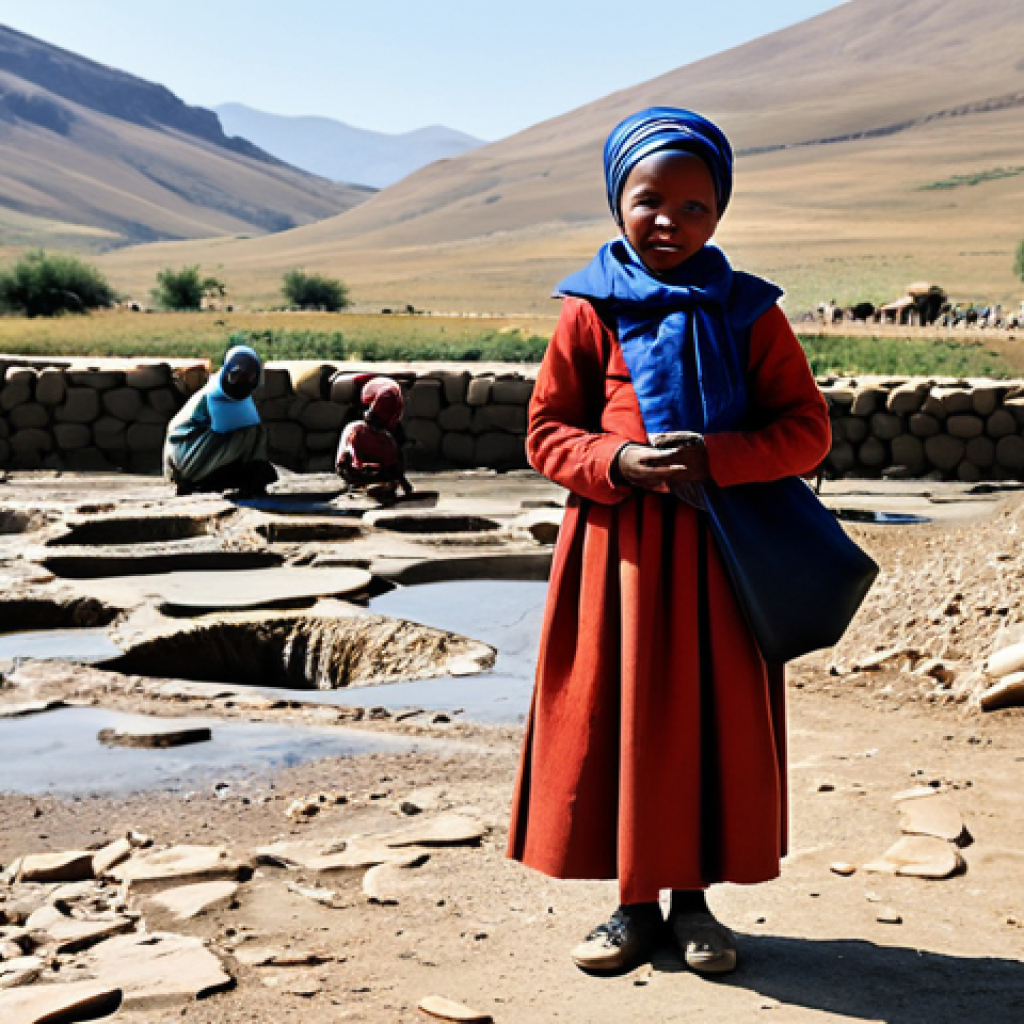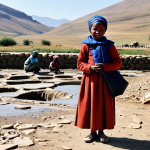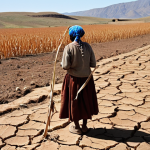Lesotho, often called the ‘Kingdom in the Sky,’ captivates with its breathtaking mountain landscapes and pristine air. Yet, beneath this tranquil veneer, a profound battle is being waged against the relentless forces of climate change.
I’ve witnessed firsthand how the once-predictable seasons, so vital for the Basotho way of life, are transforming into a chaotic, unpredictable dance of extremes.
It’s not just an abstract concept; you can feel the tension in the air when the rains don’t come, or when they arrive with destructive fury. Experts and recent analyses continually highlight how this small, landlocked nation is disproportionately affected, facing an escalating crisis of water scarcity and food insecurity.
The shifting rainfall patterns, increased frequency of droughts, and sudden, violent floods are reshaping livelihoods, challenging traditional farming practices, and pushing vulnerable communities to their absolute limits.
This isn’t merely about environmental statistics; it’s about the very real struggles of people adapting to a future where their most basic resources are increasingly precarious.
We’re seeing a rapid acceleration of these trends, demanding urgent and innovative solutions for survival and sustainable development. Let’s dive deeper below.
The Shifting Rhythms of the Sky Kingdom: A Water Crisis Unfolding

The very soul of Lesotho, its lifeblood, has always been water. I remember visiting a small village high up in the mountains, seeing the pristine streams flow, knowing how central they were to every aspect of life – from drinking to washing to nurturing crops.
But what I’ve witnessed more recently is a stark, heartbreaking transformation. The once dependable riverbeds are now often cracked and parched, their murmuring replaced by a ghostly silence.
This isn’t just about less rain; it’s about the very timing and intensity of it. What used to be gentle, soaking rains are now often short, violent downpours that cause immediate runoff, eroding the precious topsoil without truly replenishing groundwater reserves.
It’s a cruel paradox: sometimes too much water, but never enough when it truly matters. The communal taps, once flowing freely, now have scheduled hours, creating queues that stretch for what feels like miles, a tangible sign of daily struggle.
People wake before dawn, buckets in hand, because access to this most basic resource has become a desperate lottery. This impacts everything, from hygiene in homes to the health of livestock, casting a long, dark shadow over the future of entire communities.
It’s a continuous, grinding pressure that reshapes daily routines and deepens anxieties, turning a fundamental right into a luxury.
1. From Abundance to Scarcity: Lesotho’s Vulnerable Water Sources
It’s hard to reconcile the image of a ‘Kingdom in the Sky’ with the grim reality of water scarcity, but that’s precisely the challenge Basotho people face.
The highlands, traditionally a crucial water catchment area for not just Lesotho but also South Africa, are experiencing a devastating shift. I’ve personally seen the diminishing levels in dams that once seemed inexhaustible.
What compounds this is the lack of robust infrastructure to capture and store the erratic rainfall. When heavy rains do come, they often lead to flash floods, washing away vital infrastructure and causing immediate devastation rather than providing a sustainable water supply.
This isn’t just about environmental statistics; it’s about the very real struggles of people trying to secure the most basic of necessities. Communities are forced to rely on unprotected sources, increasing the risk of waterborne diseases, especially among children.
It’s a vicious cycle where environmental degradation directly translates into human suffering and a continuous battle for survival.
2. The Ripple Effect: Beyond the Tap
The implications of this water crisis extend far beyond simply having less to drink. Imagine a life where every decision, from planting crops to sending your children to school, hinges on whether there will be enough water.
I’ve heard stories from farmers who, after generations of knowing exactly when to plant their maize, now face an impossible gamble. The unpredictable nature of the rainy season means that crops often wither before maturity, leading to devastating losses.
This creates a cascade of problems: food insecurity, dwindling incomes, and an increase in rural-to-urban migration as people seek better prospects, placing further strain on urban resources.
The economic fabric of entire villages is fraying, with women and children bearing the brunt of the burden, walking longer distances to fetch water and sacrificing education or other productive activities.
It’s a stark illustration of how environmental shifts can unravel the intricate tapestry of a society.
Harvesting Hope Amidst Despair: Farming in a Changing Climate
Walking through the fields in Lesotho, especially during what should be the growing season, offers a stark, visual lesson in climate change. I’ve seen vibrant green pastures turn to brittle brown dust in a matter of weeks, fields of hopeful maize shrivel and die under an unforgiving sun.
It’s gut-wrenching to witness the sheer effort and hope poured into these lands, only for it to be dashed by extreme weather. Traditionally, agriculture, particularly rain-fed subsistence farming, has been the backbone of rural livelihoods.
It’s what sustains families and communities. But the shifting rainfall patterns and extended dry spells have made this way of life incredibly precarious.
Farmers, who have passed down knowledge through generations, now find their wisdom challenged by an erratic climate that defies traditional understanding.
It’s not just about losing a crop; it’s about losing a sense of identity, a connection to the land, and the very means of survival for many families.
1. Seeds of Change: Adapting Agricultural Practices
Despite the profound challenges, there’s a powerful spirit of resilience, and I’ve seen communities starting to embrace innovative agricultural practices.
Farmers are experimenting with drought-resistant crops, though options are limited and often expensive. There’s a growing interest in conservation agriculture – techniques like minimum tillage, direct seeding, and crop rotation – which aim to improve soil health and water retention.
I visited a small demonstration plot where a farmer was meticulously mulching his crops, explaining how it kept the soil moist for longer periods. It’s a slow, painstaking process of learning and adaptation, often without the necessary resources or technical support.
But the sheer determination is palpable. People are trying to find solutions, to keep their families fed, even as the odds stack against them. This kind of grassroots innovation, born of necessity, is truly inspiring.
2. Livestock Under Threat: A Culture at Risk
Livestock are more than just assets in Lesotho; they are a vital part of the Basotho culture, a symbol of wealth, and a crucial source of sustenance. Yet, I’ve seen firsthand how herds are dwindling, their health deteriorating due to lack of grazing land and water.
The degradation of rangelands, exacerbated by drought and overgrazing, means less fodder for sheep, goats, and cattle. This directly impacts wool and mohair production, which are key exports and income sources for many rural households.
Imagine the despair of a herder watching his animals, his entire livelihood, waste away. It’s not just an economic loss; it’s an emotional one, disrupting a way of life that has been passed down for centuries.
The need for sustainable grazing management and alternative feed sources is more urgent than ever.
Powering Tomorrow: Lesotho’s Leap Towards Green Energy
When you’re high in the Maloti Mountains, the air feels clean, the sun abundant. It makes you wonder why a country so blessed with natural resources still struggles with energy access, especially in remote areas.
I’ve often seen villages light up at night not with electricity, but with dim kerosene lamps, their smoky glow a reminder of the energy poverty that still grips much of the nation.
It’s a stark contrast to the potential for clean, renewable energy that’s practically baked into the landscape. Lesotho has immense hydroelectric potential, thanks to its extensive river systems, and an abundance of sunshine perfect for solar power.
Harnessing these resources isn’t just about addressing energy needs; it’s about building a more resilient, sustainable future that can withstand the shocks of climate change and provide vital services to every citizen.
1. Hydro-power: Lesotho’s Sleeping Giant
Lesotho’s ‘water tower’ status isn’t just about sending water downstream; it holds the promise of significant hydroelectric power generation. I’ve visited parts of the Lesotho Highlands Water Project and seen the sheer scale of the dams.
While the initial phases focused on water transfer, there’s immense potential for expanding clean energy generation within Lesotho itself. However, the reliance on rainfall makes this source vulnerable to climate variability – less rain means less power.
The challenge lies in optimizing existing infrastructure and developing new, smaller-scale hydro projects that can provide localized power without relying on large, climate-sensitive reservoirs.
It’s a complex balancing act, but one that offers incredible opportunities for energy independence.
2. Solar Solutions: Brightening Rural Lives
Solar power, for me, feels like the most immediate and tangible solution for many remote Basotho communities. I’ve seen pilot projects where small solar panels have literally transformed households – allowing children to study after dark, powering essential medical equipment in clinics, and even enabling small businesses to operate.
The sun is an abundant resource, and its consistent availability, unlike erratic rainfall, makes it a reliable energy source. The challenge is the upfront cost and maintenance.
If these can be overcome through affordable financing and local training, solar power could be a game-changer, reducing reliance on expensive and polluting fossil fuels and truly electrifying the ‘Kingdom in the Sky’ in a sustainable way.
Echoes from the Mountains: Community Voices of Resilience
There’s an incredible spirit of resilience among the Basotho people. I’ve sat with community leaders, with farmers, with grandmothers, and heard their stories.
It’s never a narrative of passive victimhood, but one of persistent adaptation, of trying to find a way forward even when the path is obscured. This isn’t just about grand national strategies; it’s about local wisdom, shared experiences, and communities coming together to face a common threat.
The traditional knowledge embedded in their farming practices, their understanding of the land, and their communal support systems are invaluable assets in this fight.
It’s in these everyday acts of coping and adapting that the true strength of Lesotho lies.
1. Local Adaptation Strategies: Learning from Generations
I often feel that the most profound lessons on climate adaptation come not from textbooks, but from the people who live closest to the land. I’ve seen communities reviving traditional rainwater harvesting techniques, building small earth dams, and implementing age-old soil conservation methods like contour ploughing – often with very limited external support.
These are not always ‘high-tech’ solutions, but they are practical, effective, and deeply embedded in the local context. The challenge is scaling these efforts and sharing best practices across different villages, ensuring that successful innovations are not isolated but become widespread.
This requires listening to, and empowering, local communities, recognizing their deep knowledge of their own environment.
2. The Power of Partnership: NGOs and Local Initiatives
While government efforts are crucial, I’ve observed firsthand the vital role that non-governmental organizations and international partners play on the ground.
They bring resources, technical expertise, and a different perspective, often working directly with communities to implement adaptation projects. I remember a project that introduced improved cookstoves, significantly reducing the need for firewood and thus lessening deforestation pressures.
These partnerships aren’t always perfect, but when they work, they empower local leaders, provide training, and help pilot sustainable solutions that can then be adopted more broadly.
It’s a testament to the idea that global challenges require collaborative, multi-faceted responses.
Beyond Borders: The Global Stakes in Lesotho’s Fight
It’s easy to think of climate change in a small, landlocked nation like Lesotho as an isolated issue, but that couldn’t be further from the truth. What happens in the ‘Kingdom in the Sky’ has ripple effects that extend far beyond its borders.
I’ve seen how interconnected everything is – from the water flowing into South Africa, powering its industries and sustaining its populations, to the impact of global emissions on Lesotho’s fragile ecosystem.
This isn’t just a local problem; it’s a microcosm of a global crisis, and it highlights our collective responsibility. The actions taken (or not taken) in powerful industrial nations directly translate into devastating droughts or floods for vulnerable communities like those in Lesotho.
It’s a vivid reminder that climate justice isn’t an abstract concept; it’s about tangible impacts on real lives.
1. Climate Finance: A Moral Imperative
For nations like Lesotho, contributing very little to global emissions yet bearing the brunt of their impact, climate finance isn’t charity; it’s a matter of justice.
I’ve spoken with local officials who describe the immense difficulty in securing adequate funding for adaptation projects. Building resilient infrastructure, implementing early warning systems, or transitioning to sustainable agriculture requires significant investment, far beyond what a developing economy can manage alone.
The pledges made by developed nations for climate finance often fall short, or the funds are difficult to access due to bureaucratic hurdles. It’s a frustrating reality, where the countries least responsible are often left scrambling for resources to survive a crisis they didn’t create.
2. Lesotho’s Voice on the Global Stage
Despite its small size, Lesotho has a powerful story to tell on the global stage. Its vulnerability makes it a compelling advocate for stronger climate action and greater support for adaptation efforts.
I’ve followed discussions where Basotho representatives passionately articulate the urgent need for global solidarity and concrete commitments. Their lived experience provides an undeniable urgency to the abstract policy debates.
By sharing their challenges and their innovative solutions, Lesotho contributes significantly to the global understanding of climate change’s human dimension, reminding the world that behind every statistic is a person, a family, a community fighting for their future.
The Human Toll: Health, Migration, and the Hidden Burdens
Climate change isn’t just about environmental shifts; it’s profoundly impacting human health and well-being in ways that are often overlooked. I’ve seen firsthand how unpredictable weather patterns can lead to outbreaks of waterborne diseases when floods contaminate sources, or how prolonged droughts exacerbate malnutrition, especially in children.
It’s a silent crisis that compounds existing vulnerabilities, creating a cycle of poverty and ill health that is incredibly difficult to break. The emotional and mental toll on communities constantly living with uncertainty, wondering if the next season will bring famine or flood, is immense and often invisible to outsiders.
1. Health Crises Amplified by Climate Change
The link between climate change and health is stark here. I’ve observed that during periods of extreme drought, people are forced to use unsafe water sources, leading to a rise in diarrheal diseases.
Conversely, intense rains and floods often lead to a surge in vector-borne illnesses as standing water creates breeding grounds for mosquitoes. Moreover, food insecurity driven by crop failures directly impacts nutritional status, particularly among infants and young children, leading to stunting and increased susceptibility to other diseases.
It’s a complex web where environmental changes directly undermine public health efforts, placing an enormous strain on already stretched healthcare systems.
2. Internal Migration and Displacement: A Silent Exodus
As traditional livelihoods become unsustainable, I’ve seen a subtle but growing trend of internal migration within Lesotho. People from remote rural areas are increasingly moving to urban centers like Maseru, seeking opportunities that no longer exist in their villages.
This isn’t always a direct “disaster displacement” in the dramatic sense, but a slow, grinding process where cumulative environmental pressures make staying untenable.
This puts immense pressure on urban infrastructure, creates informal settlements, and often leads to new social challenges. It’s a quiet exodus, driven by a desperate search for security and survival, a symptom of the deepening climate crisis impacting the very fabric of society.
Guardians of the Maloti: Protecting a Fragile Ecosystem
Lesotho’s natural beauty is undeniable, a landscape of rolling mountains, deep valleys, and unique biodiversity. I’ve hiked through parts of the Maloti-Drakensberg Park and been struck by its untouched grandeur.
But beneath this beauty lies a fragile ecosystem that is highly susceptible to the impacts of climate change. The same forces that threaten human livelihoods also endanger the unique flora and fauna that call these mountains home.
Protecting this natural heritage isn’t just about environmentalism; it’s about safeguarding the very source of clean water, medicinal plants, and the ecological balance upon which human life depends.
It’s a deeply personal issue, because when you spend time there, you feel connected to the land and its creatures.
1. Biodiversity Under Threat: Unique Species at Risk
The Maloti Mountains are a biodiversity hotspot, home to numerous endemic species that exist nowhere else on Earth. I’ve heard conservationists express deep concern about how changing temperature patterns and altered rainfall could push these unique species to the brink.
Higher temperatures can shift vegetation zones, impacting specialized habitats, while erratic water availability affects aquatic life. Protecting these species requires concerted conservation efforts, often against the backdrop of communities struggling with basic survival.
It’s a delicate balance, trying to meet human needs while safeguarding the irreplaceable natural heritage of the “Kingdom in the Sky.”
2. The Role of Conservation in Climate Resilience
Healthy ecosystems are inherently more resilient to climate shocks. I’ve seen how well-managed rangelands can better withstand drought, and how intact wetlands can act as natural sponges, mitigating flood impacts.
This means conservation efforts are not just an add-on; they are fundamental to building overall climate resilience. Initiatives focused on sustainable land management, combating soil erosion, and reforestation are crucial.
They improve water retention, reduce flood risks, and provide alternative livelihoods, demonstrating that environmental protection and human well-being are inextricably linked.
It’s about working with nature, not against it, to build a more secure future.
| Climate Impact Category | Observed Effects in Lesotho | Direct Human Impact |
|---|---|---|
| Water Scarcity & Erratic Rainfall | Drying rivers, reduced dam levels, flash floods, unpredictable rainy seasons. | Increased walking distances for water, crop failure, sanitation issues, health risks. |
| Food Insecurity & Agricultural Decline | Decreased crop yields (maize, sorghum), livestock losses, land degradation. | Malnutrition, loss of income, increased poverty, dependence on food aid. |
| Ecosystem Degradation | Soil erosion, rangeland deterioration, biodiversity loss, changes in vegetation. | Reduced natural resources, limited fodder for livestock, impacts on traditional medicine. |
| Health Vulnerabilities | Increased waterborne diseases, respiratory issues from indoor pollution, malnutrition. | Higher mortality rates, strain on healthcare systems, reduced productivity. |
| Economic & Social Disruption | Rural-to-urban migration, strained urban resources, loss of traditional livelihoods. | Social unrest, displacement, increased informal settlements, educational disruptions. |
Closing Thoughts
Having spent time among the resilient Basotho people, witnessing their daily struggles and unwavering spirit, it’s clear that Lesotho’s climate story is a powerful testament to both human vulnerability and incredible strength.
Their fight isn’t just theirs; it’s a stark mirror reflecting our global interconnectedness. We must not only acknowledge their plight but actively support their innovative adaptation efforts and champion climate justice.
The ‘Kingdom in the Sky’ truly holds lessons for us all.
Useful Information
1. To delve deeper into the specific climate challenges Lesotho faces, seek out reports from the UN Environment Programme (UNEP) or reputable local non-governmental organizations (NGOs) working on environmental issues.
2. Consider supporting established international charities or local initiatives focused on sustainable agriculture, water access, and community resilience in Lesotho, such as World Vision or CARE.
3. Educate yourself on the principles of climate justice and advocate for stronger international climate finance commitments to help vulnerable nations adapt to a crisis they largely didn’t create.
4. Explore ways to reduce your personal carbon footprint, as collective action on a global scale is essential to mitigating the effects of climate change in places like Lesotho.
5. If you’re inspired to do more, look into ethical tourism or volunteer opportunities that directly support local communities and sustainable development projects within Lesotho, ensuring your contribution is impactful.
Key Takeaways
Lesotho, the ‘Kingdom in the Sky,’ faces a severe water crisis and agricultural challenges due to erratic climate patterns, impacting its vital resources and livelihoods.
Despite being a minimal contributor to global emissions, its communities bear a disproportionate burden, highlighting the urgent need for global climate justice and support for local adaptation strategies.
The Basotho people demonstrate incredible resilience through grassroots innovation, yet international solidarity and investment in green energy and sustainable practices are crucial for their long-term survival and prosperity.
Frequently Asked Questions (FAQ) 📖
Q: How does the climate crisis in Lesotho really manifest in people’s daily lives, beyond just the headlines about shifting weather patterns?
A: It’s not just graphs and reports, believe me. I’ve seen the worry etched on faces when the skies stay stubbornly clear well past when the first rains should have blessed the land.
It’s that gnawing fear of an empty granary, the agonizing decision of which child gets the smaller portion of pap. For the Basotho, their very rhythm of life, from planting seasons to livestock herding, is tied to the predictability of nature.
When that predictability shatters, as it has, every decision becomes a gamble. You hear stories of families having to sell off precious livestock, their only real asset, just to buy food because their crops failed, or their grazing lands turned to dust.
It’s a constant, low hum of anxiety that underscores everything, making simply existing a monumental effort for so many.
Q: Given these dramatic changes, what are Lesotho’s most critical climate-related challenges right now, and what types of innovative solutions are proving vital or are desperately needed?
A: The most brutal punches Lesotho is taking are undoubtedly water scarcity and food insecurity. It sounds simple, but think about it: water isn’t just for drinking; it’s the lifeblood of their agriculture, their animals, their very existence.
When the rains do come, they’re often too much, too fast, eroding precious topsoil and destroying what little infrastructure exists. Then come the prolonged droughts, leaving riverbeds cracked and wells dry.
I recall seeing women trekking miles, balancing heavy jerrycans on their heads, just for a meager supply. Solutions aren’t easy. We’re seeing a push for more drought-resistant crops, smarter irrigation techniques, and improved water harvesting.
There’s talk of restoring degraded rangelands and implementing early warning systems for floods. But honestly, it’s a race against time, and the scale of the problem often dwarfs the resources available.
It requires not just technology, but a deep, community-led adaptation.
Q: How are traditional Basotho farming practices and community structures adapting to these unprecedented climate challenges, and what role do they play in resilience?
A: It’s heartbreaking to see how traditional wisdom, passed down through generations, is struggling to keep pace. Basotho farmers have always known their land, understood its moods.
They knew when to plant, when to harvest, when to move their herds. But with these chaotic, extreme shifts, those age-old methods are often failing. I’ve witnessed the despair when a farmer, who’s done everything by the book, loses an entire harvest to an unexpected hail storm or a sudden dry spell.
Yet, there’s also incredible resilience. Communities are leaning on each other, sharing what little they have. There’s a renewed interest in forgotten, hardy indigenous crops that might stand a better chance.
And crucially, there’s the spirit of ‘ubuntu’ – a collective humanity – that sees neighbors helping neighbors rebuild after a flood, or sharing scarce water resources.
It’s not enough to solve the crisis, but it’s the bedrock of their survival, a testament to the human spirit in the face of overwhelming odds.
📚 References
Wikipedia Encyclopedia
구글 검색 결과
구글 검색 결과
구글 검색 결과
구글 검색 결과
구글 검색 결과


